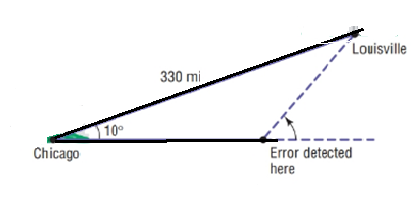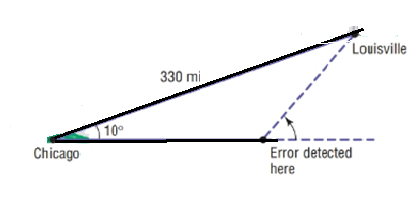
Concept explainers
a.
what angle should the pilot turn to head towards Louisville?
a.
Answer to Problem 46AYU
Explanation of Solution
Given information:
In attempting to fly from Chicago to Louisville, a distance of 330 miles, a pilot inadvertently took a course that was
If the aircraft maintains an average speed of 220 miles per hour and if the error in direction is discovered after 15 minutes, through what angle should the pilot turn to head towards Louisville?

Calculation:
Let us consider the following figure of revising a flight plan:

Let Chicago is denoted by C, Louisville is denoted by L and the Error detected point by E. So, an oblique triangle
Since speed of the aircrafts is 220 miles per hour, so in 15 minutes (1/4 hour) it will cover 220/4=55 miles. It means the distance Chicago to error detected point is 55 miles.i.e., CE=55 miles. The triangle
Now,
From the figure, we have
Hence, the pilot should turn to head towards Louisville with angle
b.
What is the new average speed?
b.
Answer to Problem 46AYU
Explanation of Solution
Given information:
In attempting to fly from Chicago to Louisville, a distance of 330 miles, a pilot inadvertently took a course that was
What new average speed should the pilot maintain so that the total time of the trip is 90 minutes?
Calculation:
The distance have to cover from the error detected point E is 276.0009miles; that is
Since he has travelled 15 minutes. So the remaining time is
Hence, the required speed
Hence, the required speed is
Chapter 8 Solutions
Precalculus Enhanced with Graphing Utilities
Additional Math Textbook Solutions
Calculus for Business, Economics, Life Sciences, and Social Sciences (14th Edition)
Elementary Statistics
Elementary Statistics: Picturing the World (7th Edition)
Intro Stats, Books a la Carte Edition (5th Edition)
Calculus: Early Transcendentals (2nd Edition)
Pre-Algebra Student Edition
- Pls help ASAParrow_forwardPls help ASAParrow_forward9. a) Determie values of a and b so that the function is continuous. ax - 2b f(x) 2 x≤-2 -2x+a, x ≥2 \-ax² - bx + 1, −2 < x < 2) 9b) Consider f(x): = 2x²+x-3 x-b and determine all the values of b such that f(x) does not have a vertical asymptote. Show work.arrow_forward
- Pls help ASAParrow_forward3. True False. If false create functions that prove it is false. Note: f(x) = g(x). a) If_lim ƒ(x) = ∞ and_lim g(x) = ∞,then_lim [ƒ(x) − g(x)] = 0 x→ 0+ x→0+ x→0+ b) If h(x) and g(x) are continuous at x = c, and if h(c) > 0 and g(c) = 0, then h(x) lim. will = x→c g(x) c) If lim f(x) = 0 and lim g(x) = 0 then lim f(x) does not exist. x-a x-a x→a g(x)arrow_forwardPls help ASAParrow_forward
- 15. a) Consider f(x) = x-1 3x+2 and use the difference quotient to determine the simplified expression in terms of x, for the slope of any tangent to y = f(x). Also, determine the slope at x = 2. 15 b) Determine the equation of the tangent to f(x) at x = 2. Final answer in Standard Form Ax + By + C = 0, A ≥ 0, with no fractions or decimals.arrow_forwardPls help ASAParrow_forwardPls help ASAParrow_forward
 Calculus: Early TranscendentalsCalculusISBN:9781285741550Author:James StewartPublisher:Cengage Learning
Calculus: Early TranscendentalsCalculusISBN:9781285741550Author:James StewartPublisher:Cengage Learning Thomas' Calculus (14th Edition)CalculusISBN:9780134438986Author:Joel R. Hass, Christopher E. Heil, Maurice D. WeirPublisher:PEARSON
Thomas' Calculus (14th Edition)CalculusISBN:9780134438986Author:Joel R. Hass, Christopher E. Heil, Maurice D. WeirPublisher:PEARSON Calculus: Early Transcendentals (3rd Edition)CalculusISBN:9780134763644Author:William L. Briggs, Lyle Cochran, Bernard Gillett, Eric SchulzPublisher:PEARSON
Calculus: Early Transcendentals (3rd Edition)CalculusISBN:9780134763644Author:William L. Briggs, Lyle Cochran, Bernard Gillett, Eric SchulzPublisher:PEARSON Calculus: Early TranscendentalsCalculusISBN:9781319050740Author:Jon Rogawski, Colin Adams, Robert FranzosaPublisher:W. H. Freeman
Calculus: Early TranscendentalsCalculusISBN:9781319050740Author:Jon Rogawski, Colin Adams, Robert FranzosaPublisher:W. H. Freeman
 Calculus: Early Transcendental FunctionsCalculusISBN:9781337552516Author:Ron Larson, Bruce H. EdwardsPublisher:Cengage Learning
Calculus: Early Transcendental FunctionsCalculusISBN:9781337552516Author:Ron Larson, Bruce H. EdwardsPublisher:Cengage Learning





